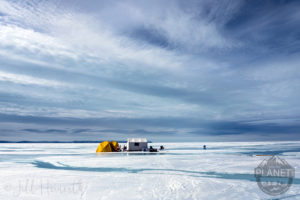Dive Nunavut
 As I try to sleep on a cot in a tent on the sea ice in Lancaster Sound, Nunavut, I am surrounded by water. The water has seeped through the seams of the floor, and even though I am pitched on top of plywood sheets, the water is getting too deep. It is time to find slightly higher ground or a remnant snow drift that has not yet melted. It is the beginning of June, and the rain is pouring down.
As I try to sleep on a cot in a tent on the sea ice in Lancaster Sound, Nunavut, I am surrounded by water. The water has seeped through the seams of the floor, and even though I am pitched on top of plywood sheets, the water is getting too deep. It is time to find slightly higher ground or a remnant snow drift that has not yet melted. It is the beginning of June, and the rain is pouring down.
The closest community is Arctic Bay some 80 km away. Arctic Bay is an amazing, traditional community located in the northwest corner of Baffin Island. This hamlet is situated upon a south-facing gravel beach on Adams Sound, which feeds into Admiralty Inlet, draining northwards to Lancaster Sound and the Northwest Passage. Nomadic people have populated it for over 5,000 years. Known as Ikpiarjuk, the Inuit call this region ‘the pocket,’ since tall cliffs surround the settlement. These cliffs provide nesting habitat for many unique species of High Arctic birds and local waters are home to narwhals and bowhead whales. That’s why I am here. Diving with narwhals and belugas is both a privilege and a rarity. With any luck, I will be able to meet these toothed whales on the floe edge, where the ocean meets ice.
But for now, I have little room to think about swimming with cetaceans. My mind is absorbed with thoughts about climate change. Local children in the hamlet were telling me that last year the bay was ice-free on July 5. The fact that kids know the precise date when the ice is gone is significant in itself. The troubling news is that everyone believes the ice will disappear earlier this year. With little experience in such matters, I would still agree. There are vast ponds of water on the surface. I have to tread carefully in tall rubber boots to get around my camp. The snowmobiles weave a circuitous path around breaks and leads in the ice. They spray a rooster tail of water skyward as they rev the motor to surf across open water breaks. Even as I walk over the surface, I have to meander to stay on safe ice.
In town, I notice that pieces of garbage that are dark in color cause small sinkholes in the ice. Their dark color absorbs heat from sunlight. They turn into virtual ice-burrowing materials that sink through the surface. Even a discarded school assignment erodes the ice. The black lines on the paper absorb heat, and the paperwork descends through the ice. It is much like our oceans in general. As the ice breaks up and the dark ocean is exposed, it becomes a heat sink for planet earth. The Arctic is warming faster than anywhere else, and the changes are exponential. It is not lost on me that the temperature today is 8°C. With 24 hour sunlight, that means things change quickly over the course of a single day. I am sunburned, and so is the ice.
